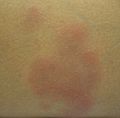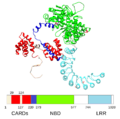Crohn's disease facts for kids
Crohn's disease is a disease that causes the intestines to become swollen. It is a type of inflammatory bowel disease (IBD). The intestines may also develop ulcers. People with Crohn's disease often have pain in the stomach, diarrhea, vomiting, and weight loss. Crohn's can also cause skin rashes, arthritis, and swollen eyes. It is named after Burrill Bernard Crohn, who described cases in 1932. It was first described by Giovanni Battista Morgagni (1682–1771) in the 18th century.
Nobody knows exactly what causes Crohn's disease. In the disease, the person's body attacks itself. The immune system attacks healthy parts of the digestive tract. This causes swelling in the digestive tract.
Though Crohn's is an immune-related disease, it is not an autoimmune disease (the immune system is not triggered by the body itself). The exact underlying immune problem is not clear. Crohn's disease seems to be connected to the person's genes. People whose brothers or sisters have the disease are the most likely to get it. Men and women can both be affected by Crohn's disease.
Managing Crohn's disease includes both lifestyle changes and various kind of medication. It is a chronic condition for which there is no cure. Certain parasitic intestinal worms appear to make the bowel less inflamed. It is supposed that the worms modify the immune reactions in the parts of the intestine where they live.
Alternative medicine of various kinds has been tried, with uncertain results.
Images for kids
-
NOD2 protein model with schematic diagram. Two N-terminal CARD domains (red) connected via helical linker (blue) with central NBD domain (green). At C-terminus LRR domain (cyan) is located. Additionally, some mutations which are associated with certain disease patterns in Crohn's disease are marked in red wire representation.
See also
 In Spanish: Enfermedad de Crohn para niños
In Spanish: Enfermedad de Crohn para niños




